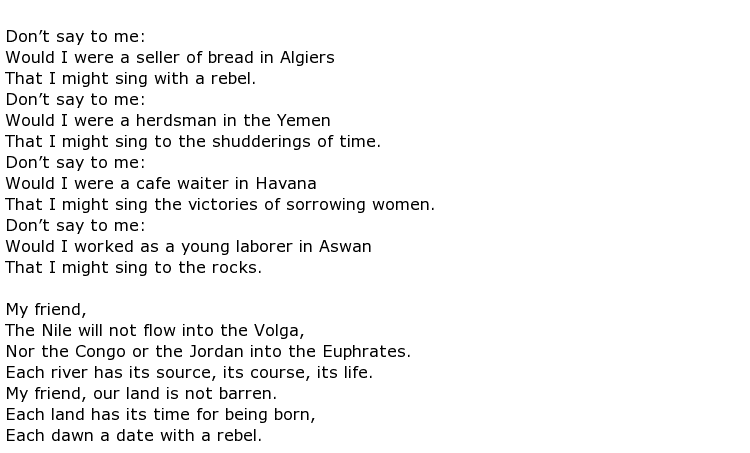 The use of poetry in the Arabic language have been in existence for hundreds and hundreds of years. Like most poetry, Arabic poetry generally involves specific meters and rhyme schemes. The meter usually applied in Arabic poetry was first identified during the 8th century by the poet al-Khalil bin Ahmad, and not much has changed regarding meter over the centuries. In Arabic poetry, the meter of a verse is not based on the stress placed on a syllable, but rather on its length. In essence, a long syllable is usually a vowel which is either followed by a consonant or a long vowel. A short syllable is always a consonant that is followed by a short vowel. Then there is the nunation sign which occurs at the end of a word, making that final syllable a long syllable. Also, in Arabic poetry, every line, called an abyat or bayt, is separated into halves, a shatrayn or a shatr.
The use of poetry in the Arabic language have been in existence for hundreds and hundreds of years. Like most poetry, Arabic poetry generally involves specific meters and rhyme schemes. The meter usually applied in Arabic poetry was first identified during the 8th century by the poet al-Khalil bin Ahmad, and not much has changed regarding meter over the centuries. In Arabic poetry, the meter of a verse is not based on the stress placed on a syllable, but rather on its length. In essence, a long syllable is usually a vowel which is either followed by a consonant or a long vowel. A short syllable is always a consonant that is followed by a short vowel. Then there is the nunation sign which occurs at the end of a word, making that final syllable a long syllable. Also, in Arabic poetry, every line, called an abyat or bayt, is separated into halves, a shatrayn or a shatr.
The rules for rhyme schemes are much more complicated than in many other languages. As with other languages, the ending of the last word in a line is used to determining other rhyming words; however, in Arabic poetry, it is strictly the last consonant of a word. When the word which is being rhymed ends in a nunation, that nunation is dropped, along with any ending vowel. Every time that ending vowel is a short “a”, or fatha, it is required to be used consistently every time that particular rhyme occurs. The short “I” and the short “u”, however are interchangeable. There is much more to the rules of writing Arabic poetry, but hopefully this very brief and incomplete introduction will provide you with some idea of the complexity of this style of poetry.
On Wishes
by Mahmoud Darwish

In general, there are two main genres of poetry in the Arabic system: romantic and satirical. A rather famous example of romantic Arabic poetry is the medieval love poem, The Story of Bayad and Riyad, or Hadith Bayad wa Riyad. This love story, which was composed in al-Andalus, was written during the 13th century. As one might be able to tell from the title, the main characters include Bayad, who is the son of a merchant as well as a foreign visitor from Damascus, and Riyad, who is the well educated daughter of an unknown minister or vizier. Riyad is in the retinue of a woman of importance in the court who is known simple as the Lady. This poem is the only known manuscript with complete illustrations to have survived many centuries of extensive foreign scrutiny.
The satirical style of Arabic poetry is referred to as hija. It was introduced as a literary form in Arabic prose in the 9th century, and soon found its way into poetry. Noted author al-Jahiz is given credit for its application, as he was known for introducing satirical comments to boring and mundane writings in order to make them more interesting to read.


You must register to comment. Log in or Register.